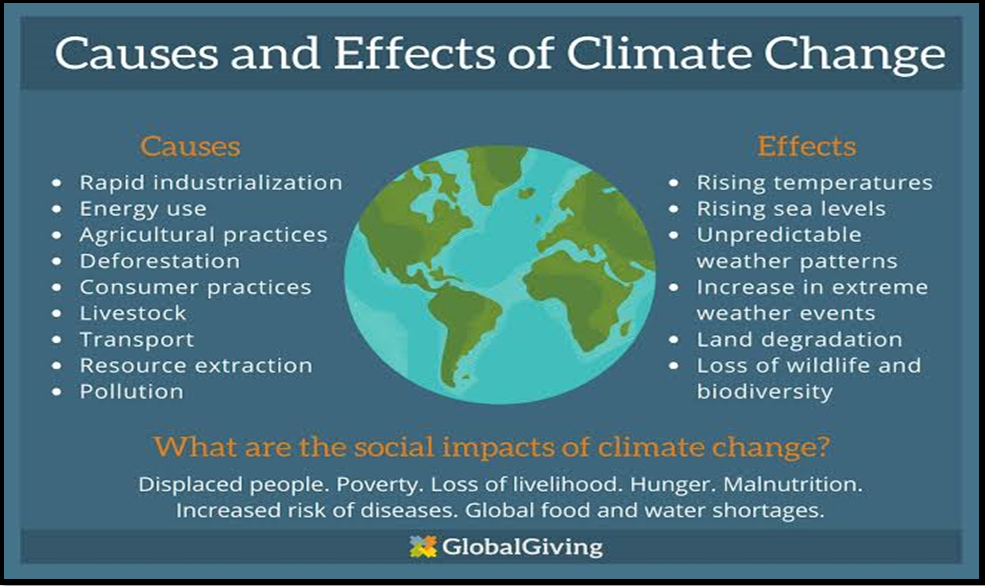COOPERATIVE FEDERALISM CAN PLUG INDIA’S CLIMATE ADAPTATION DEFICIT
Syllabus:
GS 3:
- Conservation, Environmental Pollution and Degradation, Environmental Impact Assessment.
- Disaster and Disaster Management
Why in the News?
- Climate adaptation in India is crucially in the news due to escalating climate impacts like erratic monsoons and heatwaves.
- The lack of coordinated efforts and legislative framework poses significant risks to India’s future development and the well-being of its population vulnerable to climate change-induced disasters.
Source: Global giving
The Looming Challenge
- Comprehensive plan: We need a comprehensive plan backed by resources at all levels to tackle climate change.
- Priority of Finance Commission: The 16th Finance Commission should prioritize climate adaptation efforts in India.
- Transformative innovations: India has seen transformative innovations like DPI, UPI, and DBT, showing its ability to solve complex problems.
- Existing achievements: Achievements like the PDS during the pandemic underscore India’s capability in addressing critical societal needs.
- Climate change inertia: However, inertia in climate adaptation poses a severe risk, undermining overall progress.
Impacts of Climate Change
- Diverse geography: India’s vast geography faces devastating impacts like erratic monsoons and rising sea levels.
- Existential crisis: Climate change is an existential crisis for India, home to a sixth of humanity vulnerable to disasters.
- Dependence on agriculture: India’s economy and food security depend heavily on agriculture, which is climate-sensitive.
- Reactive efforts: Despite initiatives like NAPCC, climate adaptation efforts remain slow, fragmented, and underfunded.
- Coordination gaps: Local and state-level adaptation plans lack coordination and resources, leaving communities vulnerable.
Strategic Actions Needed
- National awareness: India needs a national awareness and action plan involving experts and incentivizing private sector solutions.
- Policy initiatives: Aggressive water conservation, inter-basin water transfers, and climate-resilient crops are urgent policy needs.
- Legislative gaps: India lacks formal climate legislation at federal and state levels, hindering coordinated action.
- State capacity: Sub-national units lack fiscal resources and capacity despite being responsible for international pledges.
- Implementation challenges: Heat Action Plans and other initiatives face challenges in vulnerability assessments and compliance monitoring.
Integrating Climate Action
- Long-term investments: Long-term programmes for reforestation and urban green cover are essential amidst increasing urbanization.
- Development integration: Climate action must integrate with development promises to resonate with the masses.
- Political dynamics: There’s a disconnect where climate agendas target global platforms while development focuses on poverty alleviation.
- Business involvement: Businesses need to integrate climate action across their value chains for impactful change.
- Cooperative federalism: Cooperative federalism is crucial for integrating substantive climate action into public agendas.
Call to Action
- Finance Commission’s role: The 16th Finance Commission should prioritize climate adaptation, demonstrating national commitment.
- Adaptation urgency: Governments at all levels must align development with climate realities for smoother adaptation efforts.
- Innovation and survival: Innovation is crucial for survival amidst climate challenges, emphasizing the need for ingenuity.
- National security perspective: Climate action should be treated as a national security issue for comprehensive prioritization.
- Political will: Political hesitancy must be overcome to integrate climate action effectively without disrupting industrial status quo.
Way Forward
- Enhanced Coordination: Establish robust coordination mechanisms between central and state governments to streamline climate adaptation efforts.
- Legislative Framework: Enact comprehensive climate legislation at both federal and state levels to provide a clear mandate and framework for action.
- Capacity Building: Invest in building the capacity of local authorities and communities to effectively implement climate adaptation plans.
- Financial Allocation: Ensure adequate allocation of financial resources, with prioritization through mechanisms like the 16th Finance Commission.
- Public Awareness: Launch extensive public awareness campaigns to educate citizens about climate change impacts and adaptation measures.
- Technology and Innovation: Promote research and development of climate-resilient technologies and innovative solutions.
- Business Engagement: Encourage private sector involvement in climate action through incentives and regulations for sustainable practices.
- Monitoring and Evaluation: Implement robust monitoring and evaluation frameworks to track progress, identify gaps, and ensure accountability.
Conclusion
Effective climate adaptation requires immediate legislative action, enhanced coordination between governments, robust financial support, and widespread public engagement. India’s response will determine its resilience against escalating climate risks and its ability to safeguard the livelihoods and futures of millions.
Source:Economic Times
Mains Practice Question:
Discuss the challenges and strategies for enhancing climate adaptation in India. How can cooperative federalism play a pivotal role in mitigating these challenges?
Associated Article:
https://universalinstitutions.com/climate-change-and-indian-monsoon/




